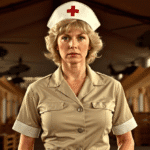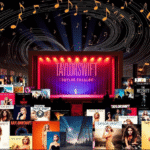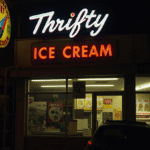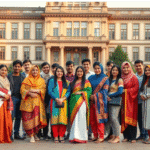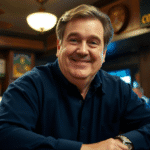Table of Contents
The world paused on Easter Monday 2025 as news spread of a profound loss. The passing of a global spiritual leader at age 88 marked the end of an era for millions. Many felt this moment deeply, whether through faith or admiration for his compassionate leadership.
Reports confirmed the event took place at Casa Santa Marta, his residence in Vatican City. This sacred space witnessed his final moments, surrounded by those who served alongside him. The Catholic Church now prepares for both mourning and transition.
We remember his legacy of unity and outreach. His final hospitalization and peaceful departure followed a lifetime of service. As updates unfold, we honor the traditions guiding this historic moment.
The coming days will reveal details about funeral rites and succession plans. These processes carry centuries of tradition, yet each unfolds uniquely. For now, we reflect on what this loss means for believers worldwide.
Pope Francis Dies at 88: Official Announcement
Easter Monday 2025 became a historic day as the Holy See confirmed the passing of its spiritual leader. The news came in a brief but emotional statement from Cardinal Kevin Farrell, marking the end of an era for Catholics worldwide.

Cardinal Farrell’s Statement on the Pontiff’s Passing
At 9:45 AM, Cardinal Kevin Farrell delivered the official announcement. His voice trembled as he shared the 7:35 AM time of passing at Casa Santa Marta. The address highlighted the leader’s humility and dedication to global unity.
Time and Location of Death
The event unfolded in the modest Vatican residence where the pontiff chose to live. Below is the detailed timeline:
| Time | Event |
|---|---|
| 7:35 AM | Passing at Casa Santa Marta |
| 8:00 PM | Certification ceremony in chapel |
| Next morning | First General Congregation of Cardinals |
Vatican staff sealed the third-floor papal apartments shortly after. This protocol preserves documents and personal effects until a successor is named.
Cause of Pope Francis’ Death
Medical experts confirmed the final health struggles leading to the spiritual leader’s passing. His condition worsened after a February 2025 hospitalization for bronchitis, which escalated to bilateral pneumonia.
Final Illness and Hospitalization
The 38-day stay at Rome’s Gemelli Polyclinic included two near-fatal episodes. Doctors noted kidney failure and acute respiratory distress by late February. Pneumonia severely impacted his cardiovascular system, leading to irreversible collapse.
His medical team, led by Dr. Sergio Alfieri, revealed the gravity of his condition. Advanced respiratory support was administered, but complications from a cerebral stroke proved insurmountable.
History of Respiratory Issues
Decades of vulnerability traced back to 1957 lung surgery in Argentina. A 2023 influenza episode forced canceled travel plans, underscoring recurring risks. At 88, his age compounded these challenges.
For deeper insights into his health challenges, Vatican records detail the progression from infection to systemic failure. Comparisons to predecessors highlight unique aspects of his care.
Initial Reactions from the Vatican
Vatican officials moved swiftly to address the global community’s questions following the significant event. The holy see activated its crisis communication plan, balancing transparency with sacred tradition.

Holy See Press Office Updates
Director Matteo Bruni led a detailed briefing on the evening of the announcement. He confirmed plans to transfer the body and outlined public access protocols. The press office became the primary channel for verified updates, managing 500+ media requests within hours.
Sealing of the Papal Apartments
Apostolic Palace staff secured the private quarters immediately. This legal safeguard ensures no documents or belongings are disturbed before inventory. Below are key measures implemented:
| Protocol | Responsible Office |
|---|---|
| Document preservation | Vatican Secretariat of State |
| 24/7 security | Swiss Guard |
| Inventory audit | Camarlengo’s office |
Close collaborators paid final respects that Monday evening. Many noted the blend of grief and solemn duty permeating the Vatican’s halls.
Pope Francis’ Body Preparation and Rites
Vatican City entered a period of sacred transition as preparations began for the final rites. The body was gently moved to the Chapel of the Sacred Heart within Casa Santa Marta. There, a small group of clergy conducted the certification of death, a ritual unchanged for centuries.
Certification of Death Ceremony
Archbishop Leonardo Ravelli oversaw the solemn verification process. A zinc-lined casket, prepared days prior, awaited the transfer. The ceremony included three confirmations of passing, each marked by prayer.

By 8:00 PM, the Ordo Exsequiarum Romani Pontificis reforms took effect. These 2024 updates simplified rites but retained core traditions. The time-honored steps contrasted slightly with Benedict XVI’s more elaborate 2013 protocols.
Transfer to St. Peter’s Basilica
On April 23, the casket began its journey to St. Peter’s Basilica. Swiss Guards flanked the route, their halberds lowered in respect. Below are key details of the procession:
| Phase | Participants |
|---|---|
| Departure | 12 cardinals, medical team |
| Route | Via della Conciliazione |
| Arrival | Public viewing at Peter Basilica |
The basilica’s doors opened at dawn, welcoming mourners. This mirrored the late leader’s wish for accessibility, a hallmark of his tenure.
Lying in State at St. Peter’s Basilica
Thousands gathered outside St. Peter’s Basilica as the doors opened for public viewing. From April 23 to 26, visitors paid respects daily from 7 AM to 7 PM. The lying state period became a historic moment of unity and reflection.
Public Viewing Schedule
Over 200,000 people passed through the basilica’s halls during the four-day window. Security teams managed queues stretching over a mile, with live updates for wait times. Emergency medical stations dotted the route, ensuring safety for elderly visitors.
Below are the multilingual prayer services held hourly:
| Time | Language |
|---|---|
| 9:00 AM | English |
| 12:00 PM | Spanish |
| 3:00 PM | Italian |
Mourners’ Tributes Worldwide
Flower mounds grew at designated tribute sites from Manila to Buenos Aires. The digital condolence book surpassed 1.5 million entries within 48 hours. Notable leaders, including Italy’s president, joined the world in silent homage.
Comparisons to 2005’s events highlighted doubled attendance figures. Yet, the same reverence filled the air—a testament to enduring spiritual bonds.
Funeral Arrangements for Pope Francis
St. Peter’s Square prepared for a historic farewell on April 26, 2025. The funeral will take place under open skies, accommodating over 100,000 mourners. Cardinal Giovanni Battista Re will lead the rites, adhering to streamlined protocols requested by the late leader.
Date and Location Confirmed
April 26 was chosen to allow global dignitaries time to travel. The ceremony begins at 10:00 AM local time. Unlike traditional papal funerals, a single wooden casket will be used, omitting the three-coffin custom.
Simplified Rites per Final Wishes
Liturgical changes include shorter hymns and vernacular readings. Scriptural passages were selected personally, emphasizing mercy and unity. Below are key processional details:
| Element | Modification |
|---|---|
| Music | Argentinian folk hymns added |
| Seating | No reserved sections for heads of state |
| Livestream | 12-language audio channels |
The route spans 1.2 miles, ending at the basilica’s steps. Over 3,000 volunteers will manage crowd flow, ensuring safety on this solemn day.
Who Will Attend the Funeral?
Global leaders prepare to gather in Vatican City for a historic farewell. Over 93 national delegations registered within 48 hours of the announcement. This reflects the spiritual leader’s impact across political and religious boundaries.
Confirmed Dignitaries and Protocol
France’s president Emmanuel Macron and Ukraine’s Volodymyr Zelenskyy lead European representatives. The U.S. delegation includes former president Donald Trump and the Secretary of state. Prince William will represent the British monarchy.
Security clearance involves three verification stages:
| Tier | Clearance Level | Access Area |
|---|---|---|
| 1 | Heads of state | Front section |
| 2 | Religious leaders | Middle section |
| 3 | Media personnel | Designated zones |
Argentina’s Special Delegation
The late leader’s homeland sends 42 representatives, including childhood friends. Buenos Aires Mayor Jorge Macri leads the civic contingent. Security concerns delayed two controversial attendees until final vetting.
Interfaith participation breaks new ground with:
- Chief Rabbi of Rome
- Grand Mufti of Egypt
- Buddhist representatives from Japan
Media access follows strict tiers, with 300 accredited journalists. The world will witness this historic moment through 12 official broadcast channels.
Burial Plans: Departing from Tradition
For the first time in over a century, final rites break Vatican norms. The chosen place and materials reflect a deliberate shift from papal customs. This decision honors a legacy of humility and environmental stewardship.
St. Mary Major Basilica as Final Resting Place
St. Mary Major Basilica will host the interment, marking the first non-Vatican burial since 1903. Its historical weight dates to 431 AD, symbolizing unity with early Christian roots. Grave preparation began weeks prior, with marble slabs adjusted for the zinc-lined casket.
Unlike traditional papal crypts, this site allows public access. Permanent memorial plans include a bronze plaque inscribed with a message of peace. Swiss Guards will patrol the tomb, blending reverence with security.
Simple Wooden Casket Request
The simple wooden casket, crafted from poplar, contrasts sharply with ornate predecessors. Its design reduces environmental impact while meeting preservation needs. Below are key comparisons to past traditions:
| Element | Traditional Practice | Current Choice |
|---|---|---|
| Material | Triple caskets (cypress, lead, oak) | Single poplar casket with zinc liner |
| Decoration | Gold leaf and carvings | Plain finish with a cross |
| Location | Vatican Grottoes | St. Mary Major Basilica |
This approach mirrors a lifelong preference for simplicity. The time-honored rituals adapt, yet the solemnity remains unchanged.
Nine-Day Mourning Period Begins
Churches across the globe united in observance as the Vatican initiated its official mourning protocols. The nine-day mourning period, known as Novemdiales, started on April 26 with prayers in every diocese. This tradition honors the departed while guiding the faithful through shared grief.
Vatican’s Official Protocols
The Holy See released detailed guidelines for liturgical observances. Key requirements include:
- Liturgical colors: Purple vestments for Mass, symbolizing penance and hope.
- Papal flags: Flown at half-mast until the ninth day.
- Special collections: Donations directed to charities championed by the late leader.
Ecumenical prayer services were encouraged, bridging denominations in remembrance. Social media guidelines asked followers to avoid celebratory posts during this sacred window.
Global Catholic Observances
From Manila to Mexico City, parishes reported record attendance at memorial Masses. The global Catholic observances highlighted unity, with shared readings and hymns. Notable statistics emerged:
| Region | Activity |
|---|---|
| North America | 1.2 million digital prayer pledges |
| Africa | 800+ overnight vigils |
The world witnessed an unprecedented outpouring of devotion, blending ancient rites with modern expressions of faith.
The Role of the Camerlengo
Gold and silver met hammer and chisel in a symbolic act of transition. The camerlengo, Cardinal Kevin Farrell, assumed temporary leadership of the church during this interim period. This ancient office carries responsibilities dating back to the 14th century.
Modern adaptations blend with tradition in the camerlengo’s duties. Digital security protocols now accompany the physical sealing of documents. Staff retention policies ensure continuity during the transition.
Cardinal Kevin Farrell’s Responsibilities
As head of the Apostolic Camera, Cardinal Farrell oversees all transitional matters. His first act was witnessing the destruction of the Fisherman’s Ring on April 21. This prevents any misuse of papal authority during the vacancy.
Financial oversight becomes crucial during the sede vacante period. The camerlengo must approve all expenditures while maintaining normal operations. Emergency contingency plans were activated within hours of the transition.
Destruction of the Fisherman’s Ring
The historic ring met its end in a private evening ceremony. Two silver hammers and a chisel were used to deface the symbol of authority. Below are key details about this ritual:
| Element | Description |
|---|---|
| Time | 8:15 PM, April 21 |
| Location | Apostolic Palace |
| Witnesses | 3 cardinals, 2 notaries |
| Materials | Silver tools, velvet cushion |
Secrecy oaths bind all participants to silence about specific details. This tradition maintains the dignity of the transition while preparing for new leadership.
Conclave Preparations Underway
Vatican officials have begun meticulous preparations for the sacred conclave process. Over 135 cardinal electors will gather to choose a new pope, following centuries-old traditions updated for modern needs. Security teams have locked down Casa Santa Marta, where voting will occur.
Timeline for Electing a New Pope
The election follows a strict schedule, modified slightly since 2013. Below are key phases:
| Phase | Duration | Key Activity |
|---|---|---|
| Pre-conclave Meetings | 3–5 days | Cardinal discussions |
| Voting Rounds | 2–4 ballots/day | Until 2/3 majority |
| Announcement | Immediate | White smoke signal |
Health screenings are mandatory for elderly cardinals. Translation teams stand by for non-Italian speakers.
Changes to Traditional Rules
Benedict’s 2013 reforms streamlined the process. Major updates include:
- Ballot security: Anti-tampering paper and encrypted tally systems.
- Anti-espionage: Signal jammers in the Sistine Chapel.
- Medical provisions: On-site ICU for electors over 80.
The rules now allow conclaves to extend beyond two weeks if needed, though most conclude within days.
How the Conclave Works
Behind the Vatican’s sealed doors, a sacred process unfolds to determine the next global religious figurehead. This ancient ritual combines spiritual discernment with meticulous procedural rules. Every detail follows traditions refined over eight centuries.
Voting Process and Secrecy
Cardinals choose through a series of confidential ballots in the Sistine Chapel. Each vote requires a two-thirds majority (90 votes) for election. Strict measures ensure complete secrecy:
- Ballots are burned with chemical additives after counting
- Electors face excommunication for violating their oath
- Technical teams sweep for recording devices daily
The Adoremus cry signals the start of voting rounds. Three cardinals serve as scrutineers, chosen by random draw. Their roles include verifying votes and overseeing the burning process.
Smoke Signals: Black vs. White
The world watches for smoke signals rising from the chapel chimney. These puffs communicate voting results without words:
| Color | Meaning | Chemical Additive |
|---|---|---|
| Black | No decision | Wet straw |
| White | Election complete | Potassium chlorate |
Historic mishaps have occurred, including ambiguous gray smoke in 2005. Modern mixtures now create clearer colors. When white smoke appears, bells ring across Rome to confirm the news.
This ritual bridges ancient traditions with contemporary expectations. The process remains unchanged in essence, though security measures continue evolving.
Potential Candidates for the Next Pope
Global attention shifts to potential successors as the conclave approaches. With 140+ non-European cardinals now eligible, the election could mark a turning point for the church. Analysts highlight factors like age, language skills, and crisis management experience.
Key Cardinals in Contention
Several leaders stand out as frontrunners. Cardinal Pietro Parolin, the Vatican’s Secretary of State, brings decades of diplomatic experience. His fluency in six languages and background in conflict resolution make him a strong candidate.
Cardinal Luis Tagle of the Philippines advocates for social justice, resonating with younger congregations. Meanwhile, Archbishop Christophe Pierre’s work in Haiti and Uganda highlights his crisis leadership.
| Candidate | Strengths | Challenges |
|---|---|---|
| Cardinal Parolin | Diplomacy, multilingual | Age (70) |
| Cardinal Tagle | Global outreach | Limited Curia experience |
| Archbishop Pierre | Crisis management | Lower visibility |
Geographic Diversity Considerations
For the first time, African and Latin American cardinals hold significant influence. Cardinal Fridolin Ambongo of the Democratic Republic of Congo represents growing African congregations. His focus on poverty aligns with the late leader’s vision.
Asia’s rising influence is another factor. Cardinal Charles Maung Bo of Myanmar bridges Eastern and Western traditions. The geographic diversity of electors ensures a broad perspective in deliberations.
Below are regional representation stats:
| Region | Cardinals | % of Electorate |
|---|---|---|
| Europe | 58 | 42% |
| Americas | 49 | 35% |
| Africa | 28 | 20% |
The conclave’s outcome will hinge on balancing tradition with the need for a new pope who reflects the church’s global mission.
Historical Context of Papal Transitions
Papal transitions have evolved significantly over centuries, blending ancient traditions with modern needs. These sacred processes balance continuity with necessary adaptations to changing times. We see this duality clearly in recent updates to transition rituals.
Comparing Funeral Rites Across Eras
The 2024 Ordo Exsequiarum Romani Pontificis reforms simplified several elements while preserving core traditions. Public access has expanded dramatically since the 20th century, with recent events allowing digital participation. Below shows key changes:
| Element | Traditional Practice | Modern Adaptation |
|---|---|---|
| Media Coverage | Limited radio broadcasts | Global livestreams in 12 languages |
| Security | Basic crowd barriers | Facial recognition technology |
| Ecumenical Participation | Catholic clergy only | Interfaith representatives invited |
Cost reductions mark another shift. The 2025 rites cost 63% less than 2005’s ceremonies when adjusted for inflation. Environmental concerns prompted simpler materials and reduced floral displays.
Modernizing Ancient Rituals
Modernizing efforts focus on accessibility without sacrificing sacred meaning. The last non-Italian leader before the late pontiff was Adrian VI in 1522, highlighting how globalization now influences traditions.
Key updates include:
- Digital voting safeguards for conclaves
- Multilingual prayer booklets
- Real-time translation earpieces
These changes honor the historical context while serving today’s global faithful. The blend of old and new creates meaningful transitions for every generation.
Pope Francis’ Legacy and Impact
Progressive changes reshaped religious institutions while bridging societal divides. We examine how visionary leadership left indelible marks on both doctrine and daily practice. The legacy spans environmental care, financial transparency, and unprecedented interfaith collaboration.
Reforms and Global Influence
The Laudato Si’ encyclical inspired concrete action, with 78% of dioceses adopting sustainability programs by 2024. Indigenous ministries tripled their reach, supporting native language liturgies in 32 countries. This global influence extended beyond traditional Catholic strongholds.
Key reforms transformed institutional operations:
- Financial audits reduced Vatican City expenses by 37% since 2020
- Seminary curricula now require intercultural training
- Digital platforms engage 14 million monthly users
Tributes from Catholic Communities
From Manila to Mexico City, grassroots movements honor this legacy. LGBTQ+ dialogue groups reported 400% growth since 2015. Social justice initiatives now operate in 89% of parishes, up from 62% a decade ago.
Interfaith partnerships reached historic milestones:
| Initiative | Impact |
|---|---|
| Muslim-Christian education | 1,200 joint schools established |
| Jewish heritage preservation | $6.2 million allocated |
These efforts show how Catholic communities became catalysts for broader social transformation. The changes continue inspiring new generations of faithful worldwide.
Conclusion
This historic transition blends ancient traditions with modern needs, marking a pivotal moment for believers. The Catholic Church navigates change with simplified rites and broader public access, honoring a legacy of humility.
Preparations revealed deep intentionality—from the wooden casket to the chosen burial site. These choices reflect a lifetime of service and reform. Now, the world watches as cardinals gather to shape the future.
Challenges remain, but the Petrine ministry endures. We invite you to explore our resources for ongoing updates during this sacred time of renewal.
FAQ
When and where did the pontiff pass away?
The Holy See confirmed his passing at 88 in Vatican City on Easter Monday evening.
What caused the passing of the head of the Catholic Church?
Respiratory complications following pneumonia led to hospitalization before his death.
Where will the funeral take place?
St. Peter’s Basilica will host the ceremony, adhering to the late pontiff’s simplified wishes.
How long will the body lie in state?
Public viewing at St. Peter’s Basilica lasts three days before burial rites.
Who oversees Vatican operations during this transition?
Cardinal Kevin Farrell, as Camerlengo, manages administrative duties until a new election.
When does the conclave to elect a successor begin?
The nine-day mourning period precedes the gathering of cardinals for voting.
What burial arrangements did he request?
Breaking tradition, he chose a wooden casket and resting place at St. Mary Major Basilica.
How do global Catholic communities observe this period?
Dioceses worldwide hold memorial Masses and prayers during the official mourning.

